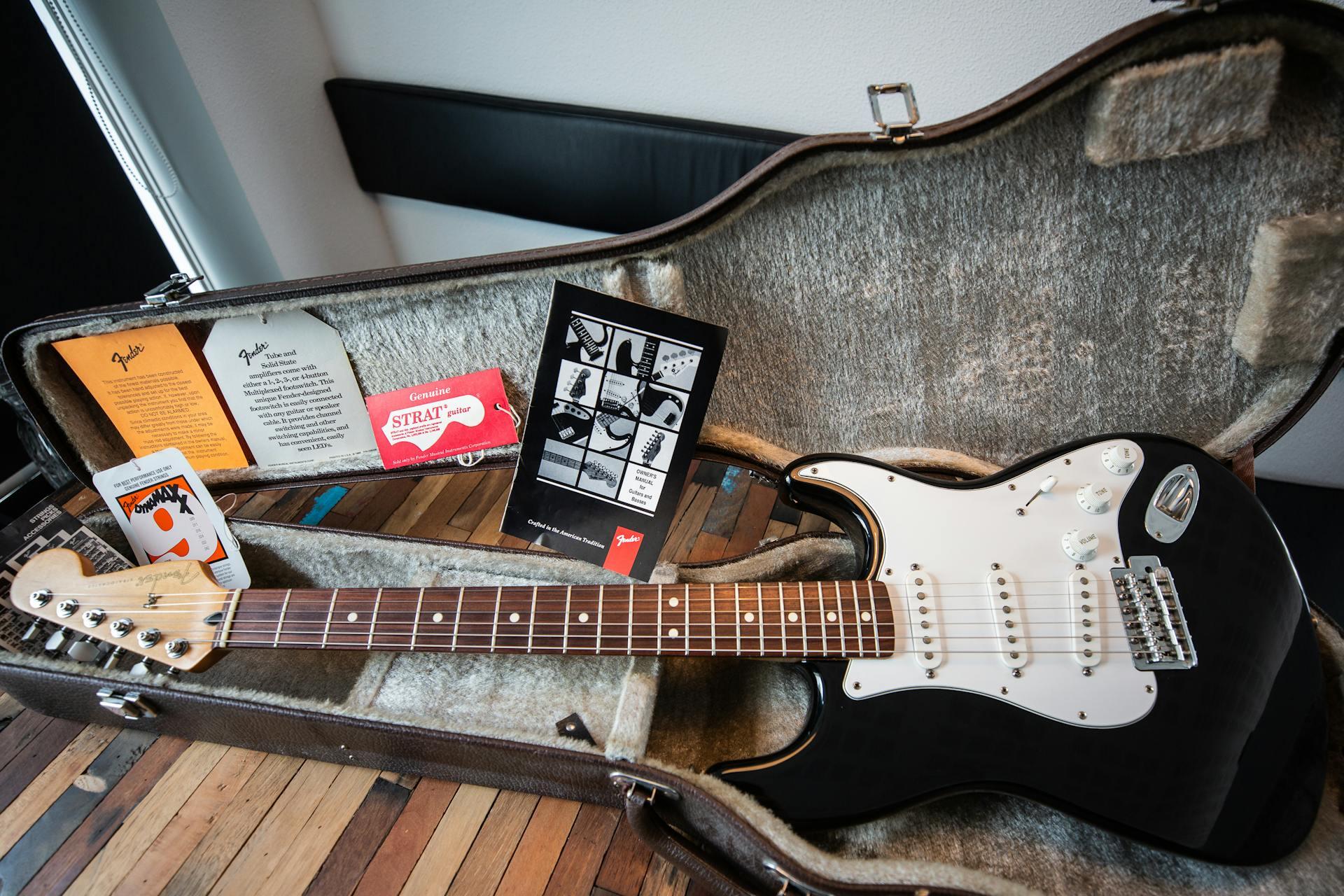How does a guitar work? This is probably the first question people ask when they pick up this popular instrument. The guitar has captured hearts across generations – regardless of gender and age. From strumming to impress others or starting bands, to moving beyond beginner chords and chasing the thrill of an epic solo before a cheering crowd, the guitar inspires every player. Some people even fantasise about smashing their guitar on stage – just like their favourite rock icons!
We can safely say that the guitar’s appeal isn’t fading anytime soon. In fact, it grows stronger with every generation, driving new techniques, riffs, and music discoveries.
But despite its charm, many aspiring players get stuck on preconceived ideas before they even begin their journeys. Some believe it’s either too difficult to learn or that they don’t have what it takes to play the instrument. Others wonder whether a tutor is essential or a waste of time and money.
In this article, we will walk you through the basics of how a guitar works while also busting the most common myths that hold beginners like you back. By the end, you’ll see why those fears shouldn’t stop you from finally starting your guitar journey and even signing up for the lessons that you’ve been putting off for many years now.
Ready to strum the strings away? Let’s dive in!


How Does a Guitar Work?
Let’s begin with the very question – how does a guitar work? Well, at its core, a guitar works the same way, whether it’s an acoustic guitar or an electric guitar; strings vibrate to create sound. When you strum or pluck the guitar strings, they vibrate and create sound waves – if you’ve touched a guitar, you should know this. Pressing the strings down on the frets along the fretboard (the long neck of the guitar) changes how much of the string vibrates, which is what gives you different notes and chords.
That’s really the magic of how you go from simple sounds to full songs. The big difference between the types of guitars comes down to how the sound is boosted. This is where legendary guitarists have experimented to craft astounding techniques and sounds. An acoustic guitar uses its hollow body to amplify the sound, while an electric guitar depends on pickups and an amp to project its voice.
If you’re curious about how this instrument has changed across centuries – from early lutes and vihuelas to the guitars we know today – you’ll find plenty of fascinating insights in the history of the guitar.
Acoustic Guitar
An acoustic guitar works by turning the vibrations of its strings into audible sound waves. When you pluck or strum the steel strings (or nylon), they vibrate at a specific frequency. The vibrations then travel through the bridge and into the guitar body or soundboard. Unlike a solid-body electric guitar, which depends on pickups and an amp signal, an acoustic relies on its hollow design. The soundboard vibrates widely in response to the string vibration, pushing the air inside the guitar and amplifying the sound naturally.
Finally, the resonance is projected outward through the sound hole, creating the warm, rich acoustic guitar sound that people love. This makes the acoustic guitar one of the most timeless and versatile musical instruments, usually used in folk, pop, and rock.
Watch the video below to understand it better with a demonstration:
Electric Guitar
An electric guitar works slightly differently from an acoustic guitar. Instead of relying on the air inside the body to project its sound, the electric guitar uses pickups to convert the vibrations of the steel strings (or nickel) into an electrical signal. When you pluck or strum the guitar strings, they vibrate over the pickups, which are magnets wrapped in coils of wire. The magnets first magnetise the strings, and as they vibrate, they disturb the pickups’ magnetic field. This movement generates a small current in the coil, essentially turning the vibration into an electrical signal.
That signal then passes through the guitar’s volume and tone knobs and out through the output jack. From there, it’s sent to an amp, which boosts the sound and can shape it further using effects like distortion or overdrive. Finally, the amp’s loudspeaker converts the signal back into a sound wave, giving the electric guitar its powerful, versatile tone.
Unlike solid-body acoustic guitars, the solid-body electric guitars (like the iconic Les Paul or even the early Rickenbacker “Frying Pan”) are built from a solid block of wood rather than relying on a hollow body. This design minimises feedback and lets the electric guitar pickups and amp do the work of shaping the sound, which is why the electric guitar became the backbone of rock, blues, metal, jazz, pop and countless modern genres.
Check out the video below for a quick demonstration.
Acoustic-Electric Guitars
An acoustic electric guitar combines the natural resonance of an acoustic guitar with the amplification power of an electric guitar. The hollow guitar body and sound hole allow the guitar strings (often steel strings or nylon) in modern models to vibrate and produce a warm, acoustic sound. Just like a traditional musical instrument, the air inside the body resonates, shaping the tone and character that players love.
What makes it different from standard acoustic guitars is the addition of pickups, usually piezo-electric transducers under the bridge, which sense the vibrations of the strings and the guitar’s body. These guitar pickups convert the vibrations into an electrical signal that can be sent to an amp. This lets guitarists play in larger venues, shape their tone with volume and tone knobs, and even blend the natural acoustic sound with electric effects for more versatility.
Watch this video for a better demonstration:
Basically, an acoustic electric guitar is like a normal acoustic guitar (the kind with a big wooden body and a hole in the middle) – you can play it without plugging it in, and it makes sound by itself, as usual.
But it also has a little microphone inside, or what we call a pickup, which lets you plug it into a speaker so it can be louder.
So, how does it differ from a normal electric guitar? You may ask. Electric guitars are made for rock sounds with lots of effects, like buzzing and screaming notes. But if you try that with an acoustic electric, the big hollow body would start making a loud, squeaky “howl” sound (feedback). So essentially, acoustic electrics are meant to sound clear and clean, just like a natural guitar, only louder.
If you’re still figuring out the basics of different guitar types, our guide on everything a beginner should know about guitar is a great place to start.
How Long Does it Take to Learn the Guitar?
After learning how different types of guitars work, from the warm sound of an acoustic guitar to the amplified power of an electric guitar and the versatility of an acoustic electric guitar, now, you might be wondering: how long does it take to learn? Many beginners hesitate because they think mastering an instrument like the guitar takes years. The truth is, it depends on your goals, the time you invest, and how consistently you practice.
You can’t see the results if you don’t practice regularly or at all. So, we put together a tentative timeline of what you can achieve if you’re consistent when it comes to your practice. Let’s take a look:
- First month: Learn basic chords (C, G, D, A, E) and strumming. and simple songs on steel string guitars or even classical guitars with nylon strings.
- 3–6 months: You’ll change chords smoothly, learn more strumming patterns, and begin to understand how strings and the fretboard work together to create music.
- 1 year: Expect to play barre chords, basic solos, and jam with friends through an amp if you play electric guitars. You’ll also develop an ear for tuning and rhythm.
- 2+ years: If you keep practising, you’ll be able to improvise, understand scales, and even compose your own music.
Ultimately, learning the guitar isn’t about speed; it’s about consistency. Even 15 minutes of daily practice is better than two hours once a week. Your progress may not look exactly as we outlined above, but progress is progress regardless.
That being said, you can achieve faster results with a tutor to guide you through your journey. A tutor plays an important role when it comes to mastering a skill. Did you know the famous guitarists like Steve Vai, Kirk Hammett (Metallica), and Larry LaLonde (Primus) were students of the famous instrumental rock guitarist, Joe Satriani?
Yes, even your favourite guitarists had tutors to coach them. You don’t need to find the most expensive tutor or class; you can begin this journey without breaking your budget, and we know the right place for you. Don’t worry about common myths around learning guitar – like needing perfect rhythm or natural talent – we’ll debunk those in the next section. (Stay tuned, and we will share with you where you can find tutors later in this article.)
Myth #1: Knowing Music Theory is Necessary to Learn How to Play the Guitar.
The guitar teachers and musicians are positive about it: no, you do not have to learn music theory to play the guitar. The power chords you need for rhythm guitar do not need academic knowledge of chord progressions. To play rock riffs or lead guitar like Eric Clapton, you do not need to know the major scale or even really the pentatonic.
Not when you are starting out on your first guitar lesson, at least. Later on, when you have the basics of rock guitar down, or you can play songs but want something more, it becomes advisable. Indeed, the guitar is one of the only instruments that does not require you to begin by learning music theory and arpeggio classes.

For the guitar, we have what the pros call a tablature. That is, a document on which you have the exact transcription of the mechanical movement of your hands. This will tell you whether to play fingerstyle or with a guitar pick, which finger to put on which fret of the guitar neck, and the rhythms that you will need to play. Guitar tabs are generally a great support for anyone wanting to play guitar music.
So you know precisely where to position your fingers to play the different notes that make up your melody just by looking at it carefully. Thus, unlike other instruments, you can play the guitar right away, without necessarily knowing music theory.
To do so, reproduce the gestures indicated on your tabs without thinking too hard about it.
That being said, if you really like the guitar, you will, at some point, learn the basics of music theory. There are several reasons for this.
- To be able to exchange easily with other musicians if you want to play in a group.
- But also to know what you play, and so to progress, maybe even compose your own music.
- Moreover, if you are a fan of jazz guitar and classical music, solfeggio will be a must.
Even then, some incredible guitar players will understand the sound of a barre chord or particular arpeggios - without the music. You can do the same through ear training.
When Theory Might be Helpful.
It's up to you to see why you want to play different guitar styles.
If it's just for fun and you plan to play something other than jazz or classical, you may not need to learn music theory.
If you want to improve, on the other hand, solfeggio will be a necessary passage. Even during private guitar classes, teachers don't always make you practice solfeggio when you're a beginner. The first steps of learning how to play the guitar are about placing your fingers on the fretboard, strumming, learning about fingerpicking and chords.
Music theory can come later on if you want to be more independent, want to start improvising, or simply want to go to the next level. And when you start looking at complex chord shapes, being able to read a chord chart will help you play acoustic guitar.
But do not worry, musicians say that by giving your best a little every day (5 to 10 minutes), you will learn in a few weeks the basics of music theory. And, some of the best guitar players - players in blues guitar or in fingerstyle - never went on a guitar course or had a guitar instructor. If they can do without the theory, so can you.

Myth #2: I'm Too Old to Learn How to Play Guitar
After the music theory (which can be a brake for some) comes the argument: it is better to learn the guitar when you are young, or can you learn some guitar tricks at any time throughout life?
It's true that as children, we can learn more quickly. We are real sponges capable of ingesting an incredible amount of information. As we grow, it becomes more difficult to retain and assimilate the same information. But this is above all concerns, annoying things that we don't like doing.
If you take pleasure, you will see that you will progress quickly - no matter your age. And above all, you will want to improve yourself and discover new things.
Moreover, many retired people choose to take up the guitar to pass the time and stay active. Because yes, the practice of an instrument is a great vehicle to continue to meet people and to make our neurons work. Not to mention that the older we get, the more time we have.
Often, a child must juggle between classes, homework, various activities and leisure activities. Once the children have grown up and left home, we finally have more time to devote to our leisure time.
Either you can spend your free time remaining passive in front of the television (which is not really stimulating for our brain) or you can enjoy yourself, learn the guitar and take a lot of pleasure playing mythical hits or create new ones.
So, as long as you can get your hands around a guitar chord, you can play. As long as you are interested in learning songs to play, you can play. As long as you are dedicated to guitar practice, you can play.
In fact, there is no age limit to playing music. It takes just the will, passion and motivation to do so. That's all.


Myth #3: How Do I Play Music If I Don't Have a Sense of Rhythm?
Not having a sense of rhythm is not an excuse, but rather an accepted idea. And a very bad one.
Obviously, when you're going to start, you will not be in rhythm (unless you're a genius or have already played a musical instrument to a high level).
But you will quickly discover this famous sense of rhythm by simply practising. Using a metronome during your exercises can be very useful for practising. This can be used to keep time whilst you are practising your basic chords, barre chords or open chords, or you can use it for jamming or to keep time to your favourite songs.
If you want a fun way to practice, learning some easy guitar songs for beginners to wow the crowd can help you naturally improve your timing.
In reality, we all have a sense of rhythm. Moreover, our daily life is rhythmic, according to different tempos. Our heart, above all, that beats steadily and constantly (with more or less speed depending on the situation).
But also according to the day/night rhythm, imposing on our body to rest at specific times and to be active during others. The seasons also come to rhythm our year with this famous cycle winter/spring/summer/autumn that repeats indefinitely.
Or the rhythm imposed by our own timetable. Some will need a faster pace than others. But we all have a clear sense of clean rhythm. So even if you aren't a born guitar player with instinctive rhythm, you can still hope to learn how to play guitar just like anyone else.
Regarding the guitar, with a good teacher, you will quickly catch the rhythm of the instrument, and you will just as quickly enter into total symbiosis with it. As you do for everyday activity. The musicians say: "The objective is to reconnect to your inner rhythm". It's beautiful and true, and if you look at the famous guitarists of all time, you’ll see that they, too, built their craft on this same principle.
Myth #4: I Don't Have the Musical Ear. This is a Handicap to playing the Guitar.
Not having a musical ear is also a preconceived idea that means absolutely nothing. Just as we have the rhythm in our blood, we all know how to listen and imitate. This is the very principle of the human being.
Should we be a real musician to play the guitar?
It was by imitating others that we were able to evolve. It was by listening to our teacher that we learned new things. We're pretty much always surrounded by music too - and a lot of this these days is guitar songs.
In fact, the real problem of our society is that we no longer know how to listen - although we are constantly surrounded by noise.
A whole bunch of nuisance prevents us from using our ears as we can use our other senses. It's a bit like if you were feeding yourself all the time with unhealthy food. Your sense of taste would be disrupted.
The practice of music enables you to use your ears fully.
Obviously, it works.
The aim is to re-learn to hear and, above all, to listen. The nuance between the two terms is important because we can hear a sound without necessarily focusing on it. This aspect of guitar playing is one of the scientifically proven benefits of playing the guitar!
Few people know how to listen. To listen means to take out a sound and to understand it. So do not worry if you do not have a musical ear. That's one thing you'll learn. Test your musical ear!
Just as you have learned to use your hands, your mouth and your eyes when you were a toddler.

Myth #5: I Don't have the Proper Hands and Fingers to Play the Guitar Well.
Still a bad excuse to avoid getting started. It is true that playing guitar requires dexterity with your fingers. But who said that only people with fine hands are clever with their fingers? This is totally wrong!
Some musicians have suffered serious accidents that have handicapped them in their hands. Other legendary guitarists had very big fingers. Yet this did not stop them from continuing to play their favourite instrument.
It's not because you have gigantic hands that you're not going to be good at the guitar. With a little training and work, you will succeed in placing your plump fingers exactly where you need them to be.
Maybe you will have a little more difficulty than other people who have fine fingers (but not necessarily more agile). We are not all equal at the physical level. That's how it should be done. Then go ahead and get to it. The human body is a beautiful machine capable of many miracles with a little hard work and willpower.
This also applies to left-handed guitarists. Just because you are not part of the majority of right-handers does not mean you'll be bad at the guitar. On the contrary! This should not be an excuse for not trying out this instrument.
So, get yourself a new guitar, tune your guitar, and get to know some basic guitar music and guitar licks. There are plenty of complex guitar techniques, but the guitar basics just require you to get to know the fretboard and to be able to put your ring finger next to your middle finger next to your index finger. Honestly, it won't take too much to learn your first song, a major chord, or the blues scale!
If you’re not sure where to start, our guide on beginner songs, shops, and the benefits of playing guitar will help you take those first steps with confidence.
Myth #6: Learning the Guitar is Too Hard
Who said that playing music was easy? Not us anyway. Learning the guitar requires time, some investment and passion. And it would certainly help if you got yourself some beginner guitar lessons - either online guitar lessons or in person. These will get you comfortable with the parts of the guitar, as well as how to tune a guitar.
After that, you will cover a chord progression (maybe from C major) and fingerstyle guitar, and you'll move on up to improvisation, chromatic techniques, and your first guitar solo.
Come on, finish with your excuses and don't believe everything that people who know nothing tell you! The guitar is like everything. As long as you are motivated, you will have everything you need to learn to play.
Maybe you are not a genius, and you will not be the new Jimi Hendrix. But at the same time, how many geniuses are there among the known and lesser-known current guitarists? Very few. Most just take pleasure in playing. And that's all that counts. In reality, the guitar is 50% passion and 50% pleasure.
Find your teacher now who will give you the right method to learn the guitar and take guitar lessons near me without waiting.
You will see: once you have started, you will find it hard to do without it.
Who knows – with time and effort, learning the guitar could even become more than a hobby and turn into a way to get paid for your skills.
Learn Guitar with Superprof in Singapore
Okay, by now, you’ve learned how a guitar works, how long it takes to master it, and we’ve even debunked some myths about learning this timeless musical instrument. So, are you ready to take the next step in your journey?
As promised, we have just the right platform for you to start your lessons – ehem, Superprof. With over 22,824 verified guitar tutors in Singapore alone, you’ll easily find someone who matches your style, whether you’re into acoustic guitars with their warm, natural sound or electric guitars with their amplified tones created by pickups, amps, and effects.
Getting started is very simple. Just head over to our website and create a free account. Once registered, you can search for guitar tutors in your area by entering “guitar” in the subject field and your location in the “postcode/address” field. From there, browse through tutor profiles to see their background, experience, teaching style, and student reviews. Whether you want to master steel strings on a classical guitar, explore soloing techniques on the fretboard, or fine-tune your tuning skills, we can guarantee that there’s a tutor for you.
Even better, you can also message tutors directly to ask questions, discuss your goals, and decide whether you want lessons online or in person. You can also find tutors outside of Singapore and attend the lessons online – we can make it happen even if your tutor is living on the other side of the world. All you need is mutual agreement and clear communication with your tutor.
The best part? Many tutors offer their first class for FREE, so you can try it out before committing. With an average lesson price of just S$35, learning to play guitar strings, chords, and even advanced techniques like barre chords or lead improvisation has never been more accessible.
Learning is made easy, convenient and flexible with Superprof, so there’s no need to wait!
The stage is set, the strings are waiting – make your guitar story happen with Superprof.














